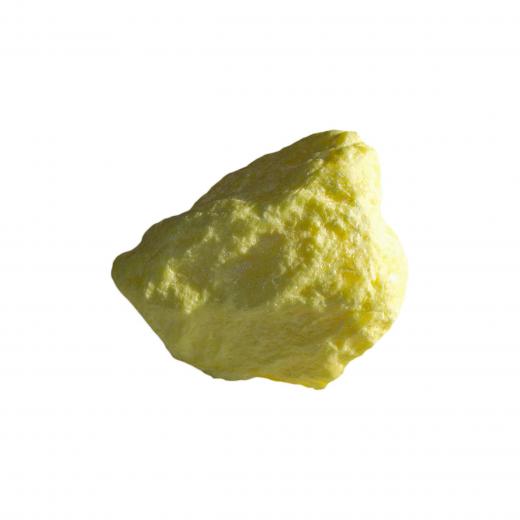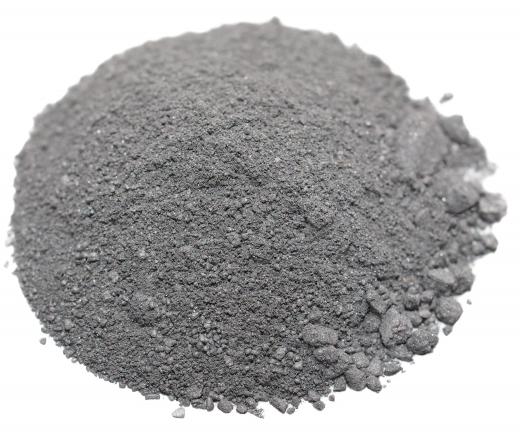What are the Properties of Sulfur?
The properties of sulfur are that it is a chemical element that is yellow, odorless, and very common near volcanic regions and hot springs. Compounds containing sulfur are of great importance in industry and biology. Sulfur has been known as brimstone, dating back to ancient times. A common alternate spelling is 'sulphur.'
Solid sulfur predominates as a ring of eight atoms, but other rings with fewer atoms are also found. When burned, sulfur exhibits a blue flame that releases sulfur dioxide, SO2. This compound can combine with water in a person’s mucous membranes to form dilute sulfurous acid, H2SO3, which acts as a weak acid.

The smell commonly associated with sulfur is not due to the elemental sulfur, but to other sulfur compounds that have formed. For instance, hydrogen sulfide, H2S, is a poisonous gas that gives off the smell of rotten eggs. Small amounts of it are formed as humidity in the air causes oxidation of sulfur. One of its sources is sewage, and it occasionally proves fatal to workers in sewage trenches. The sulfur dioxide formed from burning sulfur smells like burned matches.

Sulfur exhibits a phenomenon known as allotropism, which means that it can exist in different forms. It has crystals of different types depending on the temperature. The most common forms are known as rhombic and monoclinic. Above 356° F (96° C), the monoclinic form is stable, and below that temperature the rhombic form is the stable form.
The properties of sulfur, in its molten form, are unusual in that it is like a syrupy liquid at higher temperatures. Generally, compounds become pure liquid at high temperatures. At 593° F (160° C), the eight atom rings break open and join together. They form chains of varying lengths, ranging from eight to several thousand atoms. If liquid sulfur is poured into water quickly, it forms polymers known as plastic, or amorphous, sulfur, which can last for several days.

One property of sulfur is its tendency to combine with other compounds and form minerals. It is frequently found as sulfate and sulfide minerals. One example is iron sulfide or pyrite, FeS2, more commonly known as 'fool’s gold.' The commonly used industrial and medicinal compound Epsom salts, MgSO4.7H2O, is another example.
Sulfur is very important in biology and is required for all living cells. Several of the amino acids that make up proteins contain sulfur as part of their structure. One of these amino acids is cysteine, and it can form bonds of two sulfur groups that give a great deal of strength to proteins. This is called a disulfide bond.

Commercial processes that employ sulfur generally utilize sulfur combined with other compounds, although the vulcanization of rubber is a process that employs elemental sulfur. Sulfur is also used as a fungicide, and in the manufacture of gunpowder. Sulfuric acid, H2SO4, is a highly produced industrial chemical worldwide. It is used in the production of phosphate fertilizers, in oil refineries, and mineral extraction.
The physical properties of sulfur are that it is atomic number 16 and has an atomic weight of 32.06. It has a melting point of 235° F (113° C) and a boiling point of 832° F (444° C). Its density is 2.067 grams per cubic centimeter. There are four stable isotopes found naturally. None of them are radioactive, but the radioactive isotope 35S is used experimentally.
The chemical properties of sulfur include having common oxidation states of 6, 4, 2, and -2. Compounds such as sulfuric acid, which have an oxidation state of 6, are oxidizing agents. Other compounds with oxidation states of -2, such as hydrogen sulfide, act only as reducing agents. Elemental sulfur is not soluble in water, but can be dissolved in carbon disulfide.
AS FEATURED ON:
AS FEATURED ON:














Discussion Comments
Gunpowder was probably the biggest invention involving sulfur in the past century. Good or not, that is a different question. But gunpowder is actually a fairly simple thing. It's just made with carbon and sulfur as far as I know.
Of course, scientists are finding new uses of sulfur every day. It's a very useful element and naturally find in many things. And I'm assuming that the high melting and boiling point makes it very useful for producing that would remain hardened at normal temperatures.
@ddljohn-- Burning it and observing the flame would be one way of doing it. The color of the flame (blue) and the strange odor that is released are the trademarks. But considering the wide range of uses of sulfur, please be careful. There are some things which you should not burn to test if it has sulfur. It could be dangerous, even leading to a fire hazard.
And remember that several forms of sulfur will release toxic fumes when burned or mixed with other compounds. So don't try this type of thing unless you're very experienced in chemistry experiments. And always take the necessary precautions and wear protective clothing, gloves, masks, goggles, etc.
You can probably find out if something is made using sulfur by researching it online. Amateur experiments tend to be dangerous.
What is the best way to tell the presence of sulfur in a compound? Should it be burned to see the color of the flame? Will the odor give it away each time?
Post your comments